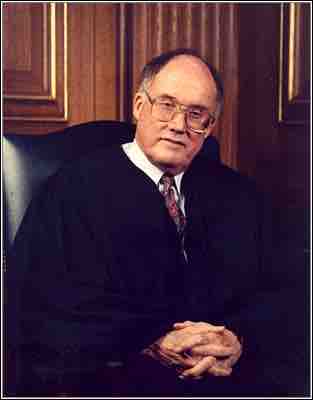William Rehnquist served as an Associate Justice on the Supreme Court of the United States, and later as the 16th Chief Justice of the United States. When Chief Justice Warren Burger retired in 1986, President Ronald Reagan nominated Rehnquist to fill the position. The Senate confirmed his appointment by a 65-33 vote and he assumed office on September 26, 1986.

William Rehnquist
Former Chief Justice William Rehnquist
Considered a conservative, Rehnquist favored a conception of federalism that emphasized the Tenth Amendment's reservation of powers to the states. Under this view of federalism, the Supreme Court, for the first time since the 1930s, struck down an Act of Congress as exceeding federal power under the Commerce Clause. He won over his fellow justices with his easygoing, humorous and unpretentious personality. Rehnquist also tightened up the justices' conferences, keeping them from going too long or off track. He also successfully lobbied Congress in 1988 to give the Court control of its own docket, cutting back mandatory appeals an certiorari grants in general.
In 1999, Rehnquist became the second Chief Justice to preside over a presidential impeachment trial, during the proceedings against President Bill Clinton. In 2000, Rehnquist wrote a concurring opinion in Bush v. Gore, the case that effectively ended the presidential election controversy in Florida, that the Equal Protection Clause barred a standard-less manual recount of the votes as ordered by the Florida Supreme Court.
The Rehnquist Court's congruence and proportionality standard made it easier to revive older precedents preventing Congress from going too far in enforcing equal protection of the laws. One of the Court's major developments involved reinforcing and extending the doctrine of sovereign immunity, which limits the ability of Congress to subject non-consenting states to lawsuits by individual citizens seeking money damages.
Rehnquist presided as Chief Justice for nearly 19 years, making him the fourth-longest-serving Chief Justice after John Marshall, Roger Taney and Melville Fuller. He is the eighth longest-serving justice in Supreme Court history.
The Roberts Court refers to the Supreme Court of the United States since 2005, under the leadership of Chief Justice John G. Roberts. It is generally considered more conservative than the preceding Rehnquist Court, as a result of the retirement of moderate Justice Sandra Day O'Connor and the subsequent confirmation of the more conservative Justice Samuel Alito in her place.
After the death of Chief Justice Rehnquist, Roberts was nominated by President George W. Bush, who had previously nominated him to replace Sandra Day O'Connor. The Senate confirmed his nomination by a vote of 78-22. Roberts took the Constitutional oath of office, administered by senior Associate Justice John Paul Stevens at the White House, on September 29, 2005, almost immediately after his confirmation. On October 3, he took the judicial oath provided for by the Judiciary Act of 1789, prior to the first oral arguments of the 2005 term.
In its first five years, the Roberts court issued major rulings on gun control. affirmative action, campaign finance regulation, abortion, capital punishment and criminal sentencing.